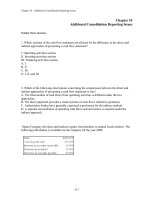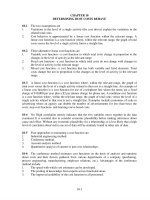Accounting26th ch 10
Bạn đang xem bản rút gọn của tài liệu. Xem và tải ngay bản đầy đủ của tài liệu tại đây (233.28 KB, 32 trang )
CHAPTER
Fixed Assets and
Intangible Assets
Warren
Reeve
Duchac
©2016
human/iStock/360/Getty Images
Accounting
26e
Nature of Fixed Assets
• Fixed assets are long-term or relatively permanent
•
•
assets such as equipment, machinery, buildings, and
land.
Other descriptive titles for plant assets or property,
plant, and equipment.
Fixed assets have the following characteristics:
o
o
o
They exist physically and, thus, are tangible assets.
They are owned and used by the company in its normal
operations.
They are not offered by sale as part of normal operations.
Classifying Costs
• A cost that has been incurred may be classified as a
•
•
fixed asset, an investment, or an expense.
Items that are classified and recorded as fixed assets
include land, buildings, or equipment. Such assets
normally last more than a year and are used in the
normal operations.
Investments are long-lived assets that are not used in
the normal operations and are held for future resale.
Such assets are reported on the balance sheet in a
section entitled Investments.
The Cost of Fixed Assets
• Only costs necessary for preparing the fixed asset for
•
use are included as a cost of the asset.
Unnecessary costs that do not increase the asset’s
usefulness are recorded as an expense. These include
the following:
o
o
o
o
o
Vandalism
Mistakes in installation
Uninsured theft
Damage during unpacking and installing
Fines for not obtaining proper permits from governmental
agencies
Capital and Revenue Expenditures
• Costs that benefit only the current period, such as
•
ordinary maintenance and repairs, are called
revenue expenditures and are recorded as increases
to Repairs and Maintenance Expense.
Costs that improve the asset or extend its useful life,
such as improvements or extraordinary repairs, are
called capital expenditures and are recorded as
increases to the fixed asset account.
Extraordinary Repairs
•
•
•
Costs related to extraordinary repairs are capital expenditures
and are recorded as a decrease in an accumulated
depreciation account.
For example, the engine of a forklift that is near the end of its
useful life may be overhauled at a cost of $4,500, extending
its useful life by eight years. The expenditure is recorded as
follows:
Because the forklift’s remaining useful life has changed,
depreciation for the forklift will also change based on the new
book value of the forklift.
Leasing Fixed Assets
•
•
A lease is a contract for the use of an asset for a period of
time.
The two parties to a lease contract are as follows:
o
o
•
The lessor is the party who owns the asset.
The lessee is the party to whom the rights to use the asset are granted
by the lessor.
Leasing an asset has the following advantages:
o
o
o
The lessee has access to an asset without having to spend funds or obtain
financing to buy the asset.
Expenses such as repair and maintenance may be the responsibility of
the lessor.
The risk of incurring additional cost because the asset may become
obsolete before the end of its useful life can be mitigated.
Depreciation
• Over time, fixed assets, with the exception of land,
•
•
•
lose their ability to provide services.
Thus, the costs of fixed assets such as equipment and
buildings should be recorded as an expense over
their useful lives.
This periodic recording of the cost of fixed assets as
an expense is called depreciation.
Because land has an unlimited life, it is not
depreciated.
Accounting for Depreciation
• The adjusting entry to record depreciation debits
•
•
Depreciation Expense and credits a contra asset
account entitled Accumulated Depreciation or
Allowance for Depreciation.
The use of a contra asset account allows the original
cost to remain unchanged in the fixed asset account.
Depreciation can be caused by physical or functional
factors.
o
o
Physical depreciation factors such as wear and tear.
Functional depreciation factors such as obsolescence.
Factors in Computing Depreciation Expense
(slide 1 of 2)
• Three factors determine the depreciation expense for
a fixed asset. These three factors are as follows:
o
o
The asset’s initial cost
The asset’s expected useful life
Estimated at the time the asset is placed into service; available from
industry trade associations
o
The asset’s estimated residual value
The residual value of a fixed asset at the end of its useful life is
also estimated at the time the asset is placed into service. Residual
value is sometimes referred to as scrap value, salvage value, or
trade-in value.
Factors in Computing Depreciation Expense
(slide 2 of 2)
• The difference between a fixed asset’s initial cost and
its residual value is called the asset’s depreciable cost.
o
The depreciable cost is the amount of the asset’s cost that is
allocated over its useful life as depreciation expense.
• If a fixed asset has no residual value, then its entire
cost should be allocated to depreciation.
Straight-Line Method
• The straight-line method provides for the same
amount of depreciation expense for each year of the
asset’s useful life.
o
Annual Depreciation = (Cost – Residual Value) / Useful Life
• If an asset is used for only part of a year, the annual
•
•
depreciation is prorated.
The computation of straight-line depreciation may be
simplified by converting the annual depreciation to a
percentage of depreciable cost.
The straight-line percentage is determined by dividing
100% by the number of years of expected useful life.
Units-of-Output Method
• The units-of-output method provides the same
•
amount of depreciation expense for each unit of
output of the asset. Depending on the asset, the units
of output can be expressed in terms of hours, miles
driven, or quantity produced.
The units-of-output method is applied in two steps:
o
Step 1. Determine the depreciation per unit as follows:
o
Step 2. Compute the depreciation expense as follows:
Double-Declining-Balance Method
(slide 1 of 2)
• The double-declining-balance method provides for a
•
declining periodic expense over the expected useful
life of the asset.
The double-declining-balance method has three steps:
o
o
o
Step 1. Determine the straight-line percentage, using the
expected useful life.
Step 2. Determine the double-declining-balance rate by
multiplying the straight-line rate from Step 1 by 2.
Step 3. Compute the depreciation expense by multiplying
the double-declining-balance rate from Step 2 times the
book value of the asset. (For the first year, the book value
of the asset is its initial cost.)
Double-Declining-Balance Method
(slide 2 of 2)
• The double-declining-balance method provides a
•
higher depreciation in the first year of the asset’s use,
followed by declining depreciation amounts. Thus, it is
called an accelerated depreciation method.
An asset’s revenues are often greater in the early
years of its use than in later years. In such cases, the
double-declining-balance method provides a good
matching of depreciation expense with the asset’s
revenues.
Depreciation for Federal Income Tax
• The Internal Revenue Code uses the Modified
•
Accelerated Cost Recovery System (MACRS) to
compute depreciation for tax purposes.
MACRS has eight classes of useful life and
depreciation rates for each class. Two of the most
common classes are the five-year class and the sevenyear class.
o
o
The five-year class includes automobiles and light-duty
trucks.
The seven-year class includes most machinery and
equipment.
Revising Depreciation Estimates
• Estimates of residual values and useful lives of fixed
•
assets may change due to abnormal wear and tear or
obsolescence.
When new estimates are determined, they are used
to determine the depreciation expense in future
periods. The depreciation expense recorded in earlier
years is not affected.
Discarding Fixed Assets
• If a fixed asset is no longer used and has no residual
•
value, it is discarded.
The entry to record the disposal of a fixed asset
removes the cost of the asset and its accumulated
depreciation from the accounts.
o
A loss is recorded if the balance of the accumulated
depreciation account is less than the balance in the fixed
asset account. These losses are reported on the income
statement.
• If an asset has not been fully depreciated,
depreciation should be recorded before removing the
asset from the accounting records.
Selling Fixed Assets
• The entry to record the sale of a fixed asset is similar
•
•
to the entry for discarding an asset. The only
difference is that the receipt of cash is also recorded.
If the selling price is more than the book value of the
asset, a gain is recorded.
If the selling price is less than the book value, a loss is
recorded.
Natural Resources
(slide 1 of 2)
• The fixed assets of some companies include timber,
•
•
metal ores, minerals, or other natural resources.
As these resources are harvested or mined and then
sold, a portion of their cost is debited to an expense
account.
This process of transferring the cost of natural
resources to an expense account is called depletion.
Natural Resources
(slide 2 of 2)
• Depletion is determined as follows:
o
o
Step 1. Determine the depletion rate as follows:
Step 2. Multiply the depletion rate by the quantity
extracted from the resource during the period.
• The adjusting entry to record depletion debits
depletion expense and credits accumulated depletion.
Intangible Assets
•
•
Patents, copyrights, trademarks, and goodwill are long-lived
assets that are used in the operations of a business and are not
held for sale. These assets are called intangible assets because
they do not exist physically.
The accounting for intangible assets is similar to that for fixed
assets. The major issues are:
o
o
•
Determining the initial cost.
Determining the amortization, which is the amount of cost to transfer to
expense.
Amortization results from the passage of time or a decline in the
usefulness of the intangible asset.
Patents
(slide 1 of 2)
• Manufacturers may acquire exclusive rights to
•
•
•
•
produce and sell goods with one or more unique
features.
Such rights are granted by patents, which the federal
government issues to inventors.
These rights continue in effect for 20 years.
A business may purchase patent rights from others.
However, if a company develops its own patent
through research and development, the costs are
usually recorded as current operating expenses in the
period in which they are incurred.
Patents
(slide 2 of 2)
• The initial cost of a purchased patent, including any
•
•
legal fees, is debited to an asset account. This cost is
written off, or amortized over the years of the
patent’s expected useful life.
Patent amortization is normally computed using the
straight-line method.
The amortization is recorded by debiting an
amortization expense account and crediting the
patents account. A separate contra asset account is
usually not used for intangible assets.
Copyrights and Trademarks
(slide 1 of 2)
• The exclusive right to publish and sell a literary,
•
•
•
artistic, or musical composition is granted by a
copyright.
Copyrights are issued by the federal government and
extend for 70 years beyond the author’s death.
The costs of a copyright include all costs of creating
the work plus any other costs of obtaining the
copyright. A copyright that is purchased is recorded
at the price paid for it.
Copyrights are amortized over their estimated useful
lives.









